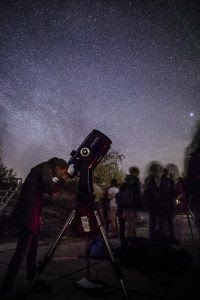UG measures darkness in the Northern Netherlands
Astronomers at the University of Groningen have set up a darkness monitoring network in the north of the Netherlands. Scientists such as the Spinoza Prizewinner Prof. Amina Helmi are concerned that darkness will disappear in Europe in the next 25 years, with far-reaching consequences for people, nature and our heritage. ‘Imagine that children born now will no longer be able to see the Plough’, says her colleague, Theo Jurriens. ‘This monitoring network makes it possible to measure darkness and if need be make preparations for the possible disappearance of darkness in our country.’ Amina Helmi: ‘I don’t think we need to switch off all artificial lighting, but more conscious and directed lighting is possible and, crucially, saves on energy.’

Four stations
The UG has set up four monitoring points: one in the residential area De Held, one at the Zernike Campus in Groningen, one in Roodeschool and one in Sellingen. These show large differences between the city and the countryside. For example, twilight has all but disappeared in the city of Groningen because of artificial lighting, while Sellingen is the darkest of the four monitoring points by far. However, even in the city differences are noticeable.
Dark Sky Park
At the request of the province of Groningen, a monitor will be placed in the Lauwersmeer National Park in early November. Lauwersmeer was designated the second Dark Sky Park in the Netherlands by the International Dark Sky Association in October 2016. A Dark Sky Park is an area in which the darkness is preserved and visitors are able to experience and the night sky. The designation of the Lauwersmeer park is exceptional, because, unfortunately, the Netherlands is one of the most light-polluted countries in the world. The darkness monitor makes it possible to measure darkness and guard its existence.
Measurements and activities
After the Lauwersmeer National Park, monitoring stations will also be set up at Hornhuizen and on the island of Ameland. The darkness monitoring stations’ measurements are presented on the website www.washetdonker.nl .
In addition to the darkness monitoring station, the UG has other astronomical activities taking place around Lauwersmeer. For example, preparations for the construction of the new Kapteyn Institute observatory are underway at the Lauwersnest activity centre in Lauwersoog. During the ‘Night of the Night’ on 26 October, visitors are invited to experience the beauty of a clear dark night in the Lauwersmeer Dark Sky Park. Visitors can look at the stars through a telescope with a UG astronomer, or experience the park at night with a park ranger. For more information and to register, go to www.np-lauwersmeer.nl.
More news
-
15 September 2025
Successful visit to the UG by Rector of Institut Teknologi Bandung
